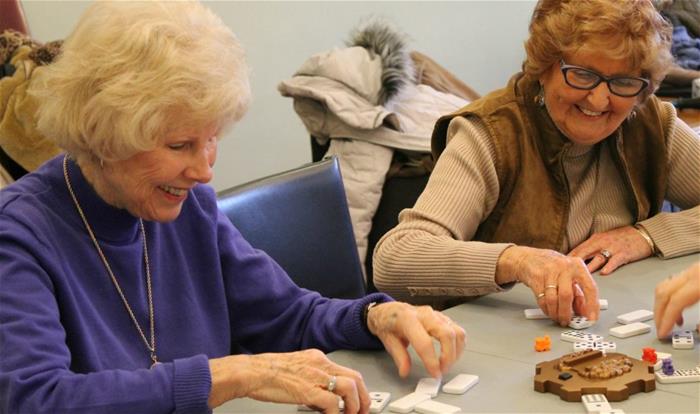
Rachel Weldrick and Stephanie Hatzifililathis (neither shown) spent a day playing — well, losing at — dominoes as they took pictures and talked to these women for the story-telling project, Seniors of Canada.
Published: ​April 9, 2018
You never know where you might find Rachel Weldrick and Stephanie Hatzifilalithis, the creators of the Seniors of Canada photo project. When they’re not working on their PhDs or TA-ing classes, they might be dodging wild shots at a tennis club or getting their clocks cleaned at dominoes in a church basement.
But on Friday April 13, you’ll find the two social gerontology graduate students at Rust City Brewery, where more than 15 photos and bios from Seniors of Canada will be on display during Art Crawl.
Seniors of Canada is modelled on Brandon Stanton’s wildly successful Humans of New Yorkproject. HONY, which has a global following of millions, is a collection of thousands of candid photos of regular people Stanton encounters every day, with a direct quote or a story about each person that he learns through chatting with them. Every photo and story is unique in its way, yet they are often relatable. Stanton doesn’t stage his photos or even include his subject’s names, and neither do Weldrick and Hatzifilalithis.
“That’s what we do,” Hatzifilalithis says, “It’s Humans of New York for seniors.”
Weldrick and Hatzifilalithis started the project because they — like most people who work in aging — were fed up with the way older people are portrayed.
“You always see one of two polarities,” Hatzifilalithis says. There are what she calls the “Viagra/Freedom 55-type” photos — affluent, attractive retirees dancing or golfing their way through their golden years — and pictures from the other extreme, of weak, frail, people who need help.
Oversimplified stereotypes like those just add to a belief that older people are all kind of the same, rather than individuals, Weldrick and Hatzifilalithis say.
“Ageism is the last acceptable prejudice in our society, and people don’t even notice it any more,” Weldrick says.
“Younger people hold a lot of assumptions and often negative beliefs about older people: What they look like, what they like, how they spend their time,” she explains. “So Stephanie came up with this project aimed at getting younger people to question their assumptions about older people.”
Weldrick, Hatzifilalithis and their team of gerontology grad students from the Gilbrea Student Group started the pilot project last year with a Student Proposal for Intellectual Community & Engaged Scholarship (SPICES) grant.
At the time, they were painfully conscious of the fact that they were a group of 20-somethings attempting to tell the stories of older people. They worried about the name they’d given their project. They wondered if they’d have trouble finding seniors who’d be willing to share their stories or have their pictures taken — they don’t recruit; they wait for subjects to come to them.
“We often overthink things,” Weldrick says with a smile. “The response has been nothing but positive. When we explain, ‘We’d like to take your picture and talk about your life,’ people are so happy to tell their stories for young people.”
Like HONY, Seniors of Canada is starting out on social media — specifically, Instagram and Facebook, where its creators hope to reach the most young people. So far, they say, the response to the first five photo stories has been great, and they have another 10 to share online, after the big reveal at Art Crawl.
The project has garnered the support of the Hamilton Council for the Aging and Schlegel Villages, which runs retirement communities around the region. And the City of Hamilton is promoting it as an example of a successful intergenerational project for its Age-Friendly City plan.
Eventually, the students hope to create a stand-alone website, and to expand beyond the Hamilton region. And to buy a team camera. (Right now, they use Hatzifilalithis’ DSLR. “They’re pretty nervous about breaking it,” she says, “so they make me go with them to every shoot.”)
When a subject agrees to join the project, they choose where to have their picture taken. The students usually spend hours or even a whole day on a single subject. “We take the pictures, but we also sit down and chat and really get to know them,” Hatzifilalithis says. “The more time you spend with them, the better. You hear so many stories and jokes — it’s just delightful.”
That’s how Hatzifilalithis and Weldrick came to spend all morning at a tennis court (“We need to take my picture doing what I love,” the man told them), followed by half a day hanging out with him and his tennis buddies at Tim Hortons.
It’s also how Weldrick found herself playing dominoes for the better part of a day. “And you can see the difference in the pictures,” Hatzifilalithis says. “Everyone is really comfortable.”
“Well sure,” Weldrick says, smiling. “They were kicking my butt.”
Even though it takes up more time than any of these grad students can spare, Seniors of Canada isn’t part of any of their academic research — SPICES grant projects can’t be. “It’s a passion project for sure,” Weldrick says. “How can it not be?”
The students have become friends with some of their subjects, especially the tennis player, who has framed prints of his favourite photos. “He’s basically part of the team now,” Hatzifilalithis says. “He’s talking us up, putting up posters, telling everyone he knows about us.”
“It means we’re doing something right,” Weldrick says. “I hope we get a picture of him standing with his Seniors of Canada photo. I know he’ll be beaming. It kind of sums the whole thing up.”
This article was first published on Daily News. Read the original article.

